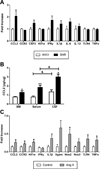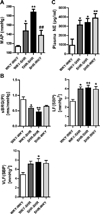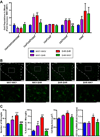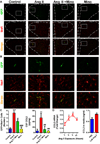Involvement of bone marrow cells and neuroinflammation in hypertension
- PMID: 25963715
- PMCID: PMC4490954
- DOI: 10.1161/CIRCRESAHA.117.305853
Involvement of bone marrow cells and neuroinflammation in hypertension
Abstract
Rationale: Microglial activation in autonomic brain regions is a hallmark of neuroinflammation in neurogenic hypertension. Despite evidence that an impaired sympathetic nerve activity supplying the bone marrow (BM) increases inflammatory cells and decreases angiogenic cells, little is known about the reciprocal impact of BM-derived inflammatory cells on neuroinflammation in hypertension.
Objective: To test the hypothesis that proinflammatory BM cells from hypertensive animals contribute to neuroinflammation and hypertension via a brain-BM interaction.
Methods and results: After BM ablation in spontaneously hypertensive rats, and reconstitution with normotensive Wistar Kyoto rat BM, the resultant chimeric spontaneously hypertensive rats displayed significant reduction in mean arterial pressure associated with attenuation of both central and peripheral inflammation. In contrast, an elevated mean arterial pressure along with increased central and peripheral inflammation was observed in chimeric Wistar-Kyoto rats reconstituted with spontaneously hypertensive rat BM. Oral treatment with minocycline, an inhibitor of microglial activation, attenuated hypertension in both the spontaneously hypertensive rats and the chronic angiotensin II-infused rats. This was accompanied by decreased sympathetic drive and inflammation. Furthermore, in chronic angiotensin II-infused rats, minocycline prevented extravasation of BM-derived cells to the hypothalamic paraventricular nucleus, presumably via a mechanism of decreased C-C chemokine ligand 2 levels in the cerebrospinal fluid.
Conclusions: The BM contributes to hypertension by increasing peripheral inflammatory cells and their extravasation into the brain. Minocycline is an effective therapy to modify neurogenic components of hypertension. These observations support the hypothesis that BM-derived cells are involved in neuroinflammation, and targeting them may be an innovative strategy for neurogenic resistant hypertension therapy.
Keywords: autonomic nervous system; bone marrow cells; hypertension; immune system; microglia.
© 2015 American Heart Association, Inc.
Figures








Comment in
-
Novel role of bone marrow stem cells in systemic disease.Circ Res. 2015 Jul 3;117(2):119-20. doi: 10.1161/CIRCRESAHA.117.306852. Circ Res. 2015. PMID: 26139857 No abstract available.
References
-
- Anderson EA, Sinkey CA, Lawton WJ, Mark AL. Elevated sympathetic nerve activity in borderline hypertensive humans. Evidence from direct intraneural recordings. Hypertension. 1989;14:177–183. - PubMed
-
- Esler M, Jennings G, Korner P, Willett I, Dudley F, Hasking G, Anderson W, Lambert G. Assessment of human sympathetic nervous system activity from measurements of norepinephrine turnover. Hypertension. 1988;11:3–20. - PubMed
-
- Dibona GF. Sympathetic nervous system and hypertension. Hypertension. 2013;61:556–560. - PubMed
-
- Bautista LE, Vera LM, Arenas IA, Gamarra G. Independent association between inflammatory markers (c-reactive protein, interleukin-6, and tnf-alpha) and essential hypertension. J Hum Hypertens. 2005;19:149–154. - PubMed

